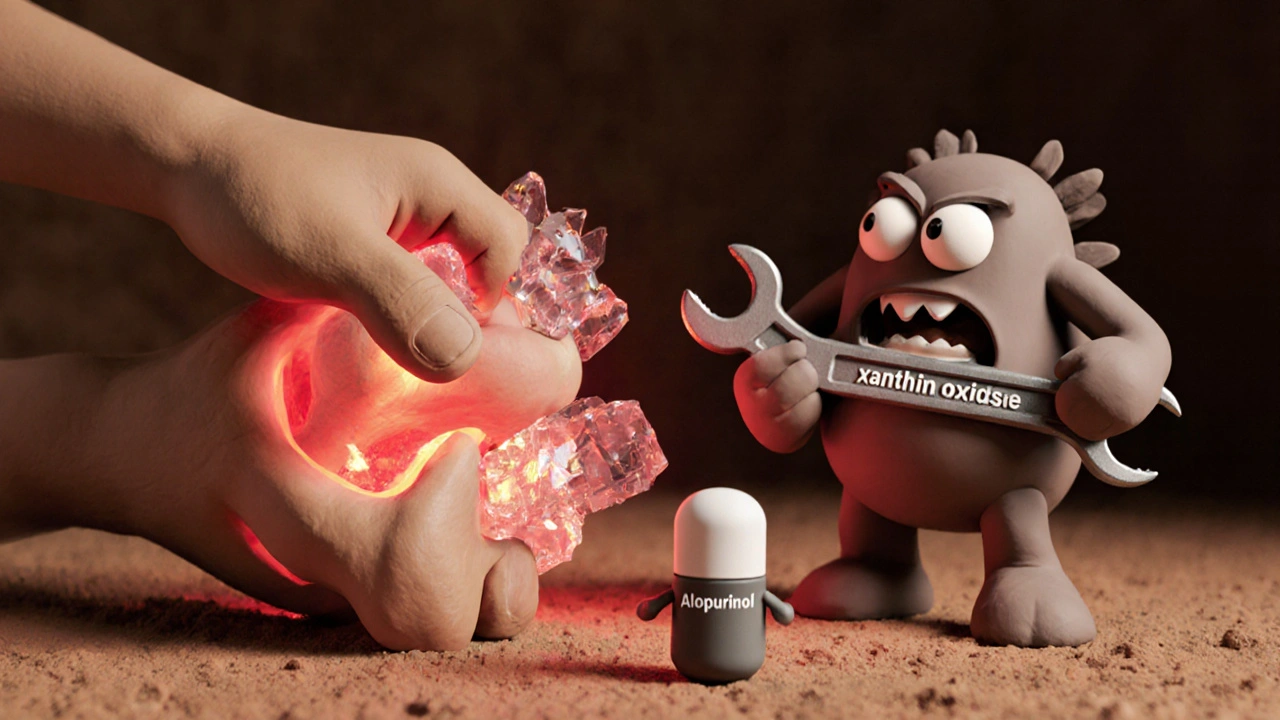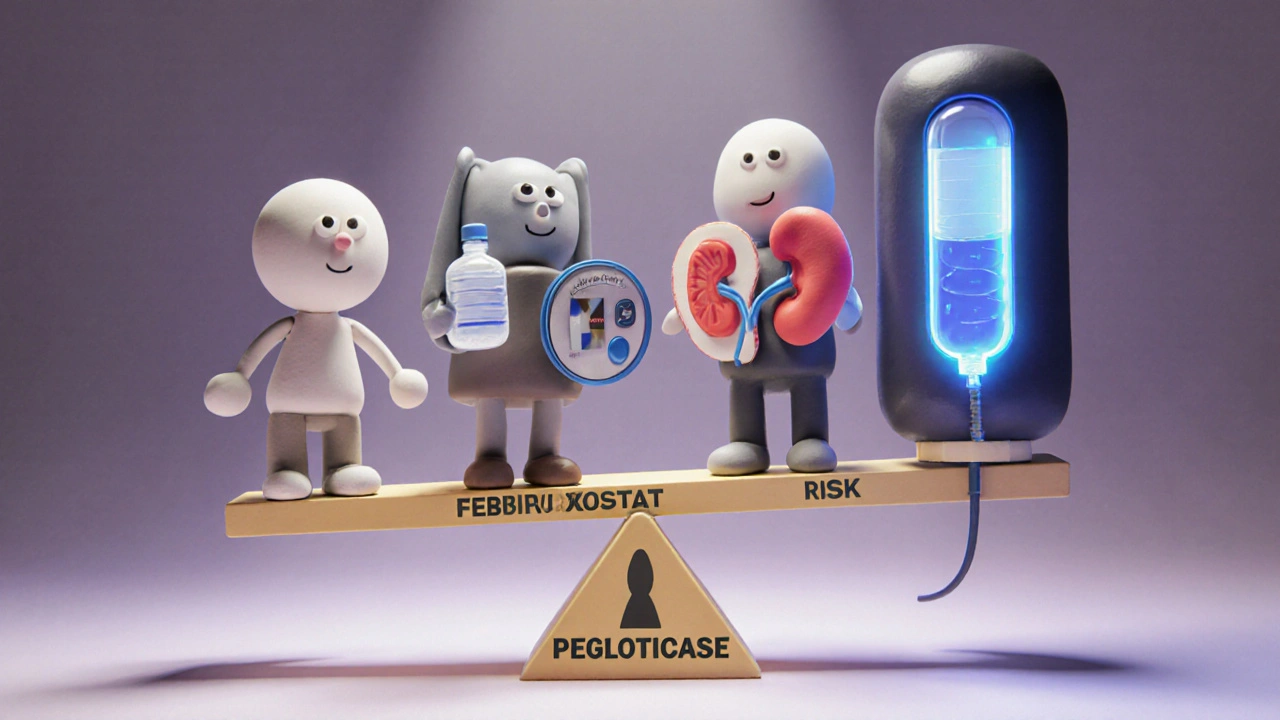Allopurinol vs Alternatives: What Works Best for Gout and High Uric Acid?

Allopurinol has been the go-to drug for gout and high uric acid for over 50 years. But it’s not perfect. Some people can’t take it. Others get side effects. And newer options are now available that work differently - and sometimes better. If you’re on allopurinol and wondering if there’s a better fit, or if you’ve been told it’s not right for you, here’s what you need to know about the real alternatives.
How Allopurinol Actually Works
Allopurinol blocks an enzyme called xanthine oxidase. That enzyme turns purines - found in meat, seafood, and some drinks - into uric acid. Less enzyme activity means less uric acid in your blood. Lower uric acid means fewer crystal deposits in your joints, which means fewer gout flares.
It’s not a painkiller. It doesn’t stop a flare once it starts. You take it daily, even when you feel fine, to prevent future attacks. Most people start at 100 mg a day. Doctors slowly increase the dose - sometimes up to 300 mg or more - until your uric acid level hits below 6 mg/dL. That’s the target.
Studies show allopurinol reduces gout flares by 60-80% over time. But about 1 in 20 people can’t tolerate it. Some get rashes. A rare but serious reaction called DRESS syndrome can happen, especially in people of Han Chinese, Thai, or Korean descent with the HLA-B*58:01 gene. Testing for that gene is now routine in some countries before starting allopurinol.
Alternative 1: Febuxostat (Uloric)
Febuxostat is the most common direct alternative to allopurinol. Like allopurinol, it blocks xanthine oxidase. But it’s a different chemical, so it works even if your body doesn’t process allopurinol well.
It’s usually started at 40 mg a day. If uric acid stays above 6 mg/dL after two weeks, the dose goes up to 80 mg. Studies show it lowers uric acid just as well - sometimes better - than allopurinol, especially in people who don’t respond to lower doses of allopurinol.
But there’s a catch. A large 2018 FDA study found a slightly higher risk of heart-related death with febuxostat compared to allopurinol in people with existing heart disease. That doesn’t mean it’s dangerous for everyone. But if you have heart problems, your doctor will likely stick with allopurinol unless you’ve had a bad reaction to it.
Febuxostat is also more expensive. In Australia, a 30-day supply costs about $30-$40 with a PBS subsidy. Allopurinol? Around $6.
Alternative 2: Probenecid (Benemid)
Probenecid doesn’t reduce uric acid production. It helps your kidneys flush it out. That’s a totally different approach.
It’s only effective if your kidneys are working well. If you have kidney disease or a history of kidney stones, probenecid isn’t a good choice. You also need to drink at least 2 liters of water a day to avoid stone formation.
It’s usually started at 250 mg twice a day, then increased slowly. It’s less potent than allopurinol or febuxostat at lowering uric acid - often not enough on its own for severe gout.
But it’s great for people who make too much uric acid but still have good kidney function. And it’s cheap. A month’s supply costs under $10 in Australia.
It’s also used with allopurinol in some cases - a combo that can push uric acid even lower than either drug alone.
Alternative 3: Pegloticase (Krystexxa)
Pegloticase is not a pill. It’s an IV infusion given every two weeks. It’s reserved for severe, treatment-resistant gout - the kind that doesn’t respond to allopurinol, febuxostat, or probenecid.
It breaks down uric acid into a substance your body can easily get rid of. It can drop uric acid to near-zero levels in weeks. Many patients with tophi (those visible lumps under the skin from uric acid crystals) see them shrink or disappear.
But it’s not simple. About 40% of people develop antibodies to it, making it less effective over time. It can cause serious allergic reactions, so it’s given in a clinic with emergency meds on hand. And it’s expensive - over $50,000 a year in the U.S., though PBS subsidies in Australia help reduce the cost.
It’s a last-resort option. But for someone with crippling, uncontrolled gout, it can be life-changing.

Alternative 4: Lesinurad (Zurampic)
Lesinurad works like probenecid - it helps the kidneys remove uric acid. But it’s only approved to be used with allopurinol or febuxostat. It’s not used alone.
It’s useful when your uric acid is still too high even after taking a full dose of allopurinol. Adding lesinurad can push levels down further.
But it’s not without risk. It can harm the kidneys, especially if you’re dehydrated. You must drink at least 2 liters of water daily. It’s also not available in Australia as of 2025. It’s been withdrawn from many markets due to safety concerns and limited benefit.
What About Natural Alternatives?
Cherry juice, vitamin C, coffee, and low-fat dairy are often touted as natural ways to lower uric acid. Some studies show small benefits - like a 10-20% drop in uric acid with daily cherry intake. But these aren’t replacements for medication.
They can help as add-ons. Drink cherry juice. Eat more low-fat yogurt. Cut back on beer and sugary drinks. But if your uric acid is above 8 mg/dL and you’ve had multiple gout flares, you need a proven drug. Don’t rely on supplements alone.
Which Alternative Is Right for You?
There’s no one-size-fits-all. Here’s how to think about it:
- If you had a rash or severe reaction to allopurinol → try febuxostat (if you don’t have heart disease)
- If you have good kidney function and make too much uric acid → probenecid could work
- If you have tophi and nothing else worked → pegloticase is an option
- If you’re still high on allopurinol → lesinurad might help (but it’s not available in Australia)
- If you’re worried about cost → allopurinol is still the cheapest and most proven
One thing’s clear: don’t stop allopurinol without talking to your doctor. Stopping suddenly can trigger a flare. Always start any new drug slowly and under supervision.

Side Effects Comparison
| Drug | Common Side Effects | Serious Risks | Special Considerations |
|---|---|---|---|
| Allopurinol | Skin rash, nausea, dizziness | DRESS syndrome (rare), severe allergic reaction | Test for HLA-B*58:01 gene in high-risk groups |
| Febuxostat | Nausea, joint pain, liver enzyme rise | Higher risk of heart-related death in those with heart disease | Avoid if you have unstable heart conditions |
| Probenecid | Stomach upset, headache, kidney stones | Worsens kidney disease, can cause stone blockage | Drink 2+ liters of water daily |
| Pegloticase | Infusion reactions, bruising, nausea | Anaphylaxis, loss of effectiveness over time | Given in clinic; only for severe, resistant gout |
What Happens If You Don’t Treat High Uric Acid?
High uric acid isn’t just about painful joints. Over time, it can cause permanent joint damage. It can lead to kidney stones. It’s linked to chronic kidney disease and even heart problems.
Many people think, “I only get a flare once a year, so I don’t need to take anything daily.” But studies show that even one flare a year increases your risk of long-term damage. The goal isn’t just to feel better - it’s to protect your body for the long haul.
When to See a Specialist
See a rheumatologist if:
- You’ve had more than two gout flares in a year
- You have tophi (visible lumps under the skin)
- Your uric acid stays above 8 mg/dL despite treatment
- You’ve had a bad reaction to allopurinol
- You have kidney disease and need a tailored plan
These aren’t emergencies. But they’re signs you need a more advanced approach than your GP can offer.
Bottom Line
Allopurinol is still the first-line choice for most people with gout. It’s cheap, effective, and well-studied. But it’s not the only option. Febuxostat is the best alternative for those who can’t take allopurinol. Probenecid works for some with healthy kidneys. Pegloticase saves people with the worst cases.
Your best move? Talk to your doctor about your uric acid level, your medical history, your budget, and your goals. Don’t assume allopurinol is your only path. There are real alternatives - and one of them might be a much better fit for you.
Can I switch from allopurinol to febuxostat on my own?
No. Never stop or switch gout medications without medical supervision. Stopping allopurinol suddenly can trigger a severe flare. Starting febuxostat requires monitoring for heart risks and liver function. Always work with your doctor.
Is allopurinol safe for people with kidney disease?
Yes - but the dose must be lowered. Allopurinol is cleared by the kidneys, so people with reduced kidney function need smaller doses. Your doctor will adjust it based on your creatinine level. Probenecid is usually avoided in kidney disease.
Why is febuxostat more expensive than allopurinol?
Febuxostat is a newer, branded drug. Allopurinol has been off-patent for decades and is made by many generic manufacturers. That drives the price down. In Australia, allopurinol costs around $6 per month with PBS subsidy; febuxostat costs $30-$40.
Do I need to avoid purine-rich foods if I’m on allopurinol?
Yes - but not as strictly as you might think. Allopurinol handles most of the excess uric acid. Still, avoiding bingeing on organ meats, shellfish, and beer helps reduce flare frequency. Diet alone won’t control gout - medication does.
How long until I see results from allopurinol or its alternatives?
It takes weeks to months. Uric acid levels drop within days, but it takes 3-6 months for existing crystals to dissolve. You might still have flares during this time. That’s normal. Keep taking your medicine. Flares decrease over time as crystals disappear.

Holly Dorger
October 31, 2025 AT 22:37i just started allopurinol last month and honestly thought i was gonna die from the rash i got on my arm. turned out it was just heat. my doctor laughed and said i shouldve gotten the gene test first. now im on febuxostat and no more flares. still scared to skip a dose though.
Amanda Nicolson
November 1, 2025 AT 01:08okay but have yall thought about how much this whole system just profits off our suffering? allopurinol costs six bucks, febuxostat costs forty, and then there's this $50k iv drip that only 2% of people even need? it's not medicine, it's a pyramid scheme with lab coats. i've been on probenecid for two years, drink water like its my job, and my tophi are shrinking. no fancy pills, no heart risks, just me and my 2 liters a day. why are we letting corporations decide what 'treatment' looks like?
Jackson Olsen
November 2, 2025 AT 09:43allopurinol worked for me till my kidneys flagged. switched to probenecid. drink water. no more flares. simple. dont overthink it
Penny Clark
November 2, 2025 AT 12:00so i tried cherry juice for 3 months after reading a blog. my uric acid dropped from 9.2 to 8.1… still way too high. my rheum told me to start allopurinol. i cried. now i take it with my coffee and its just… part of my life. like brushing my teeth. but yeah, cherry juice helps a little. maybe. 🤷♀️
Niki Tiki
November 3, 2025 AT 11:57why are we letting big pharma tell us what to take when the answer is just stop eating meat and beer? i dont need a pill for my bad choices. if you cant control your diet you dont deserve to be healthy
Nate Girard
November 3, 2025 AT 18:21just wanted to say thank you for this post. i was about to quit my meds because i thought they were useless. now i know i just need to give it time. also probenecid + allopurinol combo? that’s wild. gonna ask my doc about it
Carolyn Kiger
November 5, 2025 AT 17:11my dad had gout for 20 years. he tried everything. finally got on pegloticase. lost 12 tophi in 6 months. i cried watching him walk without a cane again. yes its expensive. yes its scary. but if you’ve suffered like he has… you do whatever it takes
krishna raut
November 6, 2025 AT 09:59in india allopurinol is ₹10/month. no one uses febuxostat unless rich. probenecid not available. diet control + water = most people manage fine
Prakash pawar
November 7, 2025 AT 11:22the real question is why we let capitalism turn biology into a product. uric acid is not a villain. it is a messenger. the body screams for balance. we ignore it with pills while the system sells us more pills. true healing is in fasting, in silence, in walking barefoot on earth. the pill is just a distraction
MOLLY SURNO
November 8, 2025 AT 10:41Thank you for the comprehensive overview. I appreciate the clear distinction between mechanisms of action and the emphasis on long-term outcomes over symptom suppression. The cost comparison across markets is particularly valuable for patients navigating insurance barriers.
Alex Hundert
November 8, 2025 AT 15:57to the person who said 'just stop eating meat' - you clearly haven't had a gout flare. i eat clean, i run 5 miles a day, and i still get flares because my body makes too much uric acid. this isn't about willpower. it's about biochemistry. stop shaming people who are trying to survive